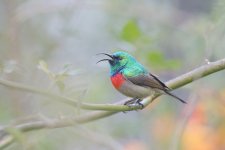Having never seen these birds before, I find it quite hard to gauge what is a 'narrow' red band and what is a 'wide' one..
https://observation.org/fotonew/0/14659870.jpg
This one was seen in a tiny patch of different trees amidst endless conifer plantations on the panorama route in Mpumalanga (it still makes me angry they dare market this as a nature destination).
https://observation.org/fotonew/0/14659870.jpg
This one was seen in a tiny patch of different trees amidst endless conifer plantations on the panorama route in Mpumalanga (it still makes me angry they dare market this as a nature destination).





